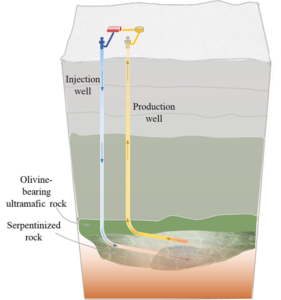
Berkeley Lab’s strategic research themes describe research programs and projects at the Lab that could make a significant contribution to the world, while also potentially providing growth opportunities for research at the Lab and for science. The two Lab research projects recently funded by ARPA-E to develop geologic hydrogen as a new source of carbon-free fuel are such projects, relating to the strategic research themes “discovering materials, chemical processes, and biological systems for energy and the environment” and “dramatically accelerating clean energy technologies.”
The Earth and Environmental Sciences Area (EESA)’s senior scientist Ben Gilbert and research scientist Mengsu Hu, both with the Energy Geosciences Division (EGD), have just embarked on two-year projects that aim to address significant challenges involved in stimulating and extracting hydrogen from rocks in Earth’s subsurface before this promising source of low-carbon energy can achieve widespread use. Ben is trying to understand the chemical mechanisms responsible for producing geologic hydrogen and then investigating ways to accelerate this process, while Mengsu’s research explores seismically safe ways to create fractures in rock, stimulate geologic hydrogen production, and ultimately transport the hydrogen back to Earth’s surface.
Ben explained: “When certain rocks encounter water, they can undergo mineralogical and chemical reduction or oxidation changes spontaneously. In a process called ‘serpentinization,’ iron-rich rock from the oceanic crust is moved up through tectonic processes, and when it meets with water, iron is released while water is reduced to hydrogen. As discovered in Mali and other places, this geologic hydrogen could be naturally formed and trapped in reservoirs. This could well be a new significant source of fuel and has led to hydrogen prospecting by energy companies.”
ARPA-E’s newly funded projects take exploring the potential of geologic hydrogen beyond locating and extracting trapped geologic hydrogen, towards the possibility that the hydrogen can actually be produced intentionally, by drilling and flowing water into rock and then transporting the hydrogen to the surface for collection.
Achieving economic hydrogen production will require new knowledge about the hydrogen generation process. “We don’t know enough about these chemical reactions that happen during serpentinization–[a process which causes the rock to release iron],” said Ben. “How does iron lose electrons and reduce water or protons to hydrogen? Does it happen at mineral surfaces? Is the process catalyzed by other metals? These are just some of the material science, chemistry, and Earth science questions that we need to answer. And, these natural processes take many years. Once we have a better understanding of these mechanisms, we can look for tools to accelerate the process,” he continued.
Ben’s project team uses quantum chemistry simulations and experiments to show that these reactions can be understood, predicted, and controlled in the laboratory and, ultimately, the field. Using rock samples from field sites in Montana and elsewhere, Mengsu’s team will deploy multiscale numerical modeling, laboratory tests, and field characterization to develop and test their technology, which aims to extract hydrogen safely and economically at a commercial scale.
“Our goal is to develop novel cyclic injection technology for the commercial extraction of geologic hydrogen without inducing harmful seismicity,” she said. “We will develop predictive understanding and technology for adaptive control of the chemo-mechanical processes associated with serpentinization. These capabilities will allow us to increase the permeability of the rocks, thus allowing access of water to drive the hydrogen generation reactions and then to extract the hydrogen without inducing seismicity.”

Lab Capabilities Apply to Geologic Hydrogen Research
Mengsu and Ben noted that the ARPA-E funded projects are already utilizing a range of Berkeley Lab capabilities, but the opportunities for the geologic hydrogen research teams to collaborate with others at the Lab will likely expand.
Said Ben, “Many ideas and capabilities in the project were enabled in the Basic Energy Sciences geoscience project at Berkeley Lab. And to study iron redox chemistry, we plan to use the Advanced Light Source (ALS). But there are also opportunities to leverage the Lab’s high-performance computing capabilities, and to work with electron microscopy experts and facilities at the Molecular Foundry.”
Said Mengsu, “This field is rich with opportunities for earth scientists and geoscientists, but there are also many research questions that require other expertise. For example, research into the transportation and storage of hydrogen will be important, and future geologic hydrogen work would likely be integrated with California’s hydrogen hub (called the Alliance for Renewable Clean Hydrogen Energy Systems or ARCHES) and other hydrogen work at the Lab.
Newsha Ajami, EESA’s Chief Strategic Development Officer, said that if and when enhanced geologic hydrogen comes to pass, there could also be research into community impact, the potential impact of geologic hydrogen on natural resources such as water, and potential unintended consequences, as well as work partnering with communities on land use issues,” she said. An example of research at Berkeley Lab that includes community impact work is the study of the possibility of a direct air capture hub while prioritizing the needs of surrounding communities.
“As we explore and transition to alternative energy sources, we will need to consider not just how to produce these fuels but also how to address demand and supply considerations, and the potential impact on communities. This means that scientists and researchers who don’t conventionally collaborate will be coming together to work with communities directly and answer some of their place-based questions. Enabling this collaboration is important,” Newsha continued.
Mengsu notes that in the course of their research, her team is making use of existing laboratory and computational capabilities that were built at the Lab and also building new capabilities that may also be useful elsewhere. For example, Mengsu’s team is building new modeling capabilities that conduct chemo-mechanical analysis to understand the mechanisms of geological hydrogen stimulation by creating fractures and introducing hot water to drive the reactions, all without inducing harmful seismicity. In addition, software for conducting smaller-scale modeling studies (CrunchFlow) will be combined with the TOUGH family of codes to analyze induced seismicity and the transport of hydrogen at reservoir scale. These software applications could potentially be applied in a wide range of settings for geologic hydrogen production and storage.
The Potential of Geologic Hydrogen Research
“Geologic hydrogen research is a new field that holds a lot of potential. The ability to extract hydrogen from rocks, if it works, could be a game-changer,” said Mengsu.
Mengsu is hopeful that if the current research projects are successful, more funding could be available, from government agencies as well as from industry. “Even before the research started, I was already contacted by mining companies and venture capital firms. They are staying close to the research on this project. And this space is rich with research questions; I can already see different follow-on research questions to explore after these projects are completed,” she said.
Mengsu notes that Berkeley Lab, with two projects under its belt, would be in a good position to work on follow-on projects.
Ben agrees. “Ultimately, this relatively new field of research into mineral processes to understand redox, and to apply it to energy challenges, could be a significant opportunity for science. And with our X-ray, electron microscopy, and high-performance computing facilities as well as our growing expertise in geologic hydrogen, Berkeley Lab has a lot to offer.”
As Ben pointed out, new sources of energy don’t come around very often. “The last new potentially significant energy resource introduced to the world was nuclear fusion. Hydrogen from the earth is potentially a significant new energy resource and one that is carbon-free. Even more broadly, beyond geologic hydrogen, there is the potential to manipulate minerals in ways that are important for energy and the environment. I’m excited to do this kind of work at Berkeley Lab, which offers so many contacts and people and resources to help move this field forward,” he said.
For more information:
“Energy Department Awards $20 Million for Research into Carbon-Free Geologic Hydrogen,” Forbes magazine, Feb. 8, 2024
“Two EGD Project Teams Selected to Receive Funding to Explore Potential of Geologic Hydrogen Energy,” EESA website, Feb. 12, 2024
Berkeley Lab hydrogen research, Berkeley Lab website

